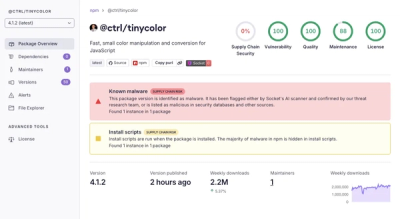TypeScript Color Class
An opinionated TypeScript/JavaScript Color class. This is what the JavaScript language should provide as the de facto Color object.
This module is a more simple alternative to the npm modules color and color-js with some important differences:
- written in TypeScript, exports an ES5 module, and ES4/legacy static build
- toString() always returns CSS-compatible color strings like
"#fff" so the color objects can be used to change CSS style values or when creating strings, eg: elm.style.color = new Color('azure')
- in addition to RGB arrays, also accepts CSS strings as inputs, eg:
new Color('rgba(255,0,0,0.5)') or new Color('#ff00ff')
- HSL calculations use floating point values between 0.0 and 1.0
- larger list of color names
- full test coverage using
npm run test and for ES5 use npm run test:es5
- invalid constructor or methods throw errors
- all setter methods are immutable, chainable, and always return a new instance of
Color
- the static minified build provides a global
Color object available in any html file
- no dependencies
- small build size (22KB)
Documentation
Install
Use NPM Module
import Color from 'ts-color-class';
Or use commonjs import syntax:
var Color = require('ts-color-class');
Or use the static build
The static build file color-class.min.js is included in the /build directory.
<script type="text/javascript" src="color-class.min.js"></script>
Usage
new Color( inputValue )
The inputValue can be one of:
- a CSS string, either a hex, rgb, rgba, or a named color
- an array of RGB values (and optionally an alpha channel)
- an HSL object
The constructor also accepts RGBA values in the form:
new Color( red, green, blue, alpha )
Here are some diifferent ways to define red:
new Color('red');
new Color('#f00');
new Color('#ff0000');
new Color('red', 0.5); // 50% transparent
new Color([255, 0, 0]);
new Color([255, 0, 0], 0.5); // 50% transparent
new Color(255, 0, 0);
new Color(255, 0, 0, 0.5); // 50% transparent
new Color('rgb(255, 0, 0)');
new Color('rgba(255, 0, 0, 0.5)'); // 50% transparent
new Color({ h: 0, s: 1, l: 0.5 });
new Color({ h: 0, s: 1, l: 0.5 }, 0.5); // 50% transparent
Color Names
Any of the colors in the named color list can be used as the input value.
The hash of names and their RGB values can be accessed using:
Color.getNames()
Methods
toString()
Returns a CSS-compatible 3 or 6 character hex string:
new Color('red').toString()
// returns "#f00"
If an alpha channel is supplied, and it is not equal to 1.0, an rgba string is returned:
new Color('red').alpha(0.5).toString()
// returns "rgba(255,0,0,0.5)"
If the alpha channel is equal to 0, then transparent is returned:
new Color('red').alpha(0).toString()
// returns "transparent"
In certain cases, such as when applying styles in CSS, using console.log(), or when manipulating strings, the .toString() is implied and can be omitted;
document.body.style.backgroundColor = new Color('red').darken(0.3);
console.log( "color = " + new Color('red').darken(0.3) );
var borderStyle = "1px solid " + new Color('red').darken(0.3);
myElement.style.border = borderStyle;
Setter Methods
All setter methods are immutable and return a new instance of Color. This means calling a method like .alpha() does not modify the object, but returns a new method with that alpha channel applied. This is useful when making modifications to a base color value but not changing the original color.
var red = new Color('red');
var blue = new Color('blue');
var darkpurple = red.combine(blue.darken(0.2)).alpha(0.5);
console.log('red = '+red);
console.log('blue = '+ blue);
console.log('darkpurple = '+darkpurple);
// OUTPUT:
// red = #f00
// blue = #00f
// darkpurple = rgba(128,0,102,0.5)
alpha( value )
Sets the alpha channel (transparency):
new Color('red').alpha(0.5).toString();
// returns "rgba(255,0,0,0.5)"
lighten( amount )
Increases the lightness value (0 - 1):
new Color('#f00').lighten(0.1).toString();
// returns '#33f'
darken( amount )
Decreases the lightness value (0 - 1):
new Color('#f00').darken(0.5).toString();
// returns '#c00'
saturate( amount )
Increases the saturation value (0 - 1):
var cornsilk = new Color('corn silk 3');
console.log(cornsilk.getSaturation());
// returns 0.2187500000000001
// increase saturation fom 0.21 to 0.31:
console.log(cornsilk.saturate(0.1).getSaturation());
// returns 0.3187500000000001
desaturate( amount )
Decreases the saturation value (0 - 1):
new Color('#d3ccab'.desaturate(0.1).toString()
// returns '#cdc8b1'
shiftHue( amount )
Adjusts the hue value (0 - 1):
new Color(255, 255, 0).shiftHue(0.25).toString();
// returns '#00ff7f'
combine( Color, percent )
Combines the color with another.
Add a percentage parameter (0 - 1) to define how much of the new color to combine:
new Color('black').combine('red', 0.5).toString();
// returns '#800000'
tint( Color, percent )
Adjusts the hue toward another color based on a percentage value (0 - 1).
This is similar to combine() but only applies to the hue, not saturation or lightness.
new Color('red').tint('blue', 0.5).toString();
// returns '#0f0'
new Color('red').tint([0,0,1], 0.5).toString();
// also returns '#0f0'
hue( value )
Sets the hue value (0 - 1):
new Color('red').hue(0.23).toString()
// returns '#9eff00'
saturation( value )
Sets the saturation value (0 - 1):
new Color(100,50,50).saturation(0.5).toString()
// returns "#712626";
lightness( value )
Sets the lightness value (0 - 1);
new Color('#cdc8b1').lightness(0.5).toString()
// returns '#9b9164'
invert()
Inverts the color:
new Color('#fff').invert().toString()
// returns '#000'
red( value )
Sets the red value (0 - 255):
new Color('black').red(255).toString()
// returns '#f00'
green( value )
Sets the green value (0 - 255):
new Color('black').green(255).toString()
// returns '#0f0'
blue( value )
Sets the blue value (0 - 255):
new Color('black').green(255).toString()
// returns '#00f'
Getter Methods
getRGB()
Returns the red, green, blue color values as an array:
console.log( new Color('red').getRGB() );
// returns [255,0,0]
getAlpha()
Returns the alpha channel value (0 - 1).
getHex()
Returns the hexidecimal css value (ignores alpha channel value).
getRed()
Returns the red value (0 - 255).
getGreen()
Returns the green value (0 - 255).
getBlue()
Returns the blue value (0 - 255).
getHSL()
Returns the hue, saturation, and lightness values as an object literal.
new Color('tan').getHSL()
// returns { h: 0.09523809523809527, s: 0.4374999999999999, l: 0.6862745098039216 }
getHue()
Returns the hue value (0 - 1);
getSaturation()
Returns the saturation value (0 - 1);
getLightness()
Returns the lightness value (0 - 1);



